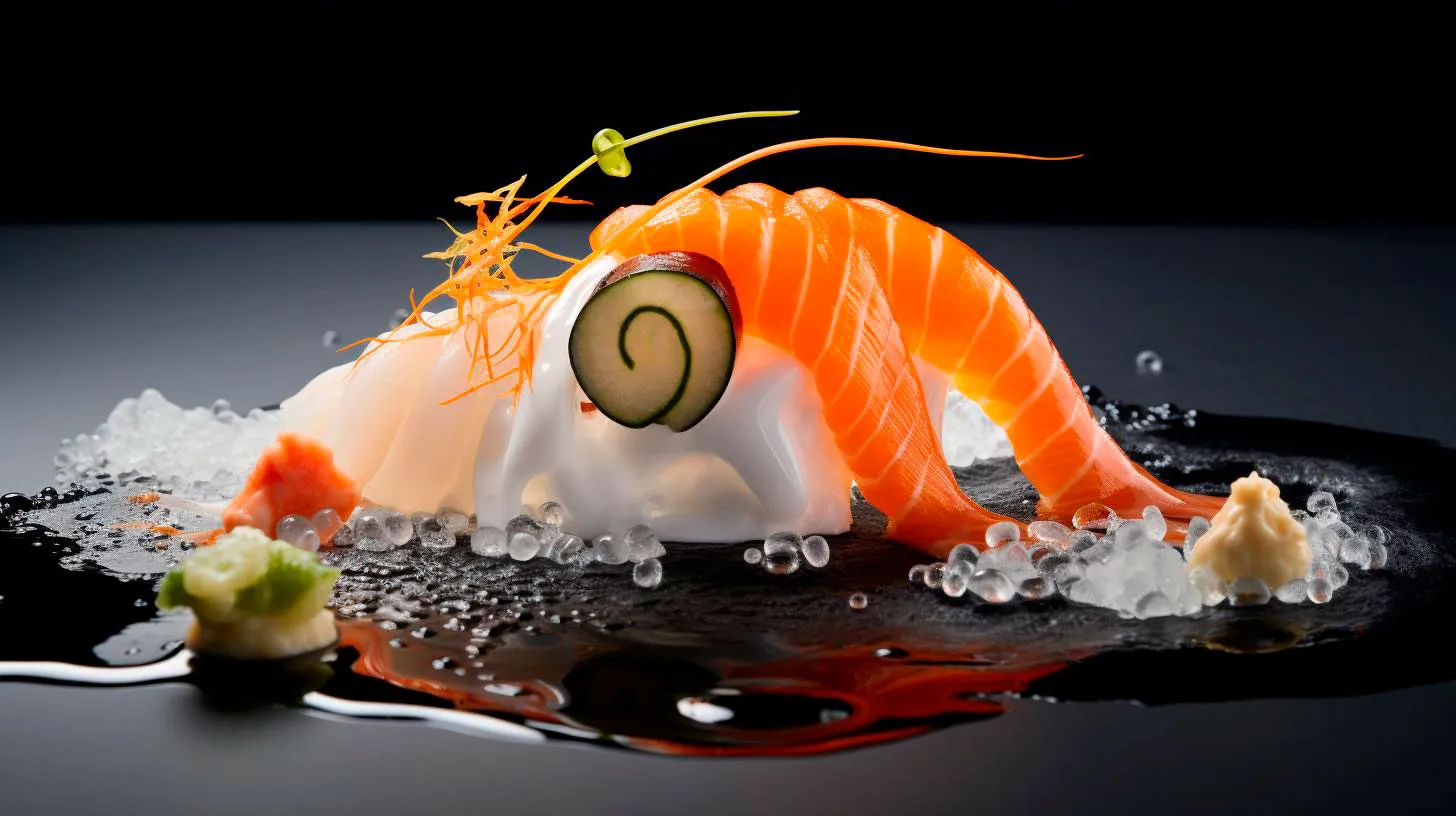From Ocean to Plate: An Exciting Journey of Rediscovering Nori Seaweed
Often associated with sushi, Nori is a versatile and nutritious sea vegetable that deserves recognition beyond its traditional usage. Join us in this captivating journey as we rediscover Nori seaweed and explore its unique qualities, benefits, and culinary applications.
Nori Seaweed: A Brief Introduction
Nori, scientifically known as Porphyra, is a type of edible seaweed commonly found along the coastlines of Japan, Korea, and China. With its beautiful dark green or purple color, Nori has gained immense popularity as an integral ingredient in sushi rolls. Traditionally, it is harvested by hand and then dried to preserve its delicate flavor and texture.
The Nutritional Powerhouse
While Nori is widely esteemed for its delicacy, it also boasts an impressive nutritional profile. Packed with essential minerals, vitamins, and antioxidants, this sea vegetable offers a range of health benefits:
- Rich in essential amino acids and proteins, Nori helps support muscle growth and repair.
- A good source of iodine, Nori promotes thyroid health and proper metabolism.
- Loaded with vitamins A, C, and E, Nori supports a healthy immune system.
- Abundant in dietary fiber, Nori aids in digestive health and promotes a feeling of fullness.
- High in omega-3 fatty acids, Nori contributes to brain health and reduces inflammation.
An Enviable Culinary Ingredient
Beyond its impressive nutritional profile, Nori also offers a diverse culinary experience. Let’s explore some exciting ways to incorporate this delicious sea vegetable into your daily meals:
- Sushi Rolls: Nori’s association with sushi is undeniable. Its delicate texture and umami taste make it a perfect wrapper for sushi rolls filled with fresh seafood, vegetables, or even fruits.
- Nori Wraps: Use Nori as a creative wrap for sandwiches, tacos, or even burritos. Its unique flavor will add a delightful twist to your favorite fillings.
- Nori Snacks: Get your daily dose of nutrients by enjoying Nori as a standalone snack. Crisp Nori sheets can be seasoned with spices or lightly salted for a satisfying and guilt-free munching experience.
- Nori Seasoning: Grind dried Nori into a fine powder and sprinkle it over salads, soups, or roasted vegetables to infuse them with an appetizing umami taste.
- Nori Soup: Add torn or sliced Nori sheets to miso or vegetable-based soups for an earthy flavor and a boost of essential minerals.
The Sustainability Factor
In today’s world, sustainability is a key consideration when choosing ingredients. Nori seaweed emerges as an environmentally friendly choice due to its sustainable cultivation practices:
- Nori farms are carefully maintained and harvested in a way that minimizes the impact on coastal ecosystems.
- Compared to land-based crops, Nori requires significantly fewer resources, including land, water, and fertilizers.
- As an underwater crop, Nori contributes to oxygen production and provides habitats for various marine species.
By incorporating Nori into our diets, we can support sustainable food practices and contribute to the well-being of our planet.
The Bottom Line
Nori seaweed offers a multitude of reasons to be celebrated, from its delightful taste to its numerous health benefits and sustainable nature. As you embark on your culinary adventures, don’t forget to add this versatile sea vegetable to your repertoire. Whether you’re a sushi lover or simply seeking a unique and nutritious ingredient, Nori is here to enchant your taste buds and contribute to your overall well-being.
Key Takeaways:
- Nori seaweed is a versatile and nutritious sea vegetable widely known for its association with sushi.
- It is rich in essential amino acids, iodine, vitamins, and dietary fiber.
- Nori can be used in multiple culinary applications, including sushi rolls, wraps, snacks, seasonings, and soups.
- Choosing Nori supports sustainable food practices and has minimal impact on coastal ecosystems.
So, the next time you savor the delightful flavors of Nori, remember the exciting journey it took from the deep ocean waters to your plate.
Beyond Traditional Sushi: Embracing Unexplored Nori Seaweed Species
The World of Nori Seaweed
Nori seaweed, often in dried and paper-thin sheets, has been a staple ingredient in Japanese cuisine for centuries. Porphyra species, such as Porphyra yezoensis and Porphyra tenera, are commonly cultivated and harvested for sushi making. However, there is a wide range of nori species that remain relatively untapped.
Exploring these unexplored nori seaweed species not only presents an opportunity to expand the culinary experience but also offers several unique advantages:
- Flavor Variations: Each nori species possesses its own distinct flavor profile, ranging from mild and savory to umami-rich and bold. Incorporating different nori species into sushi and other dishes opens up a world of flavor possibilities.
- Health Benefits: Nori seaweed is packed with essential vitamins, minerals, and antioxidants. It is an excellent source of iodine, which is essential for thyroid health. Some nori species even contain higher protein content than conventional seaweed species.
- Sustainability: Diversifying nori species in the culinary scene can help reduce pressure on commercially cultivated nori species and promote sustainable harvesting practices. It offers an opportunity to protect the delicate marine ecosystems that support these seaweeds while meeting the increasing demand.
Unexplored Nori Seaweed Species
Let’s take a closer look at some of the unexplored nori seaweed species that are worth considering:
1. Pyropia umbilicalis
Also known as “laver,” Pyropia umbilicalis has a delicate texture and a slightly salty taste. It is commonly found along the Atlantic coasts of North America and Europe. Its taste complements seafood and is excellent for creating unique sushi rolls or as a garnish for salads.
2. Monostroma spp.
Monostroma spp., also known as “green laver,” has a unique grassy flavor and a tender, crispy texture. It grows abundantly along rocky shores, and its vibrant green color adds visual appeal to any dish. Try using green laver in soups, stir-fries, or even as a topping for sushi bowls.
3. Porphyra abbottae
This particular Porphyra species is found in the Pacific Ocean and offers a delicate taste and a beautiful purple color. Its texture is slightly chewy, and it pairs well with ingredients such as avocado, cucumber, and pickled radish. Consider using Porphyra abbottae to create eye-catching sushi-rito wraps or as a unique ingredient in rice dishes.
Embrace the Nori Seaweed Evolution
As sushi continues to gain popularity worldwide, food enthusiasts and chefs are constantly exploring new ways to push the boundaries of traditional sushi. Incorporating unexplored nori seaweed species into your culinary repertoire not only allows for diverse flavor experiences but also promotes sustainability and offers various health benefits.
Key Takeaways:
- Traditional sushi primarily uses Porphyra species for nori seaweed.
- Exploring unexplored nori species brings flavor variations, health benefits, and sustainability advantages.
- Pyropia umbilicalis (laver), Monostroma spp. (green laver), and Porphyra abbottae offer unique tastes, textures, and colors.
- Consider incorporating unexplored nori seaweed species into sushi, salads, soups, stir-fries, and rice dishes.
- Embracing the evolution of nori seaweed contributes to the culinary world and showcases new possibilities beyond traditional sushi.
With a little creativity and experimentation, these unexplored nori seaweed species can unleash a whole new dimension of flavors and elevate your sushi and other dishes to extraordinary levels. So, why not dive into the unexplored, embrace the diversity of nori seaweed, and embark on a culinary adventure that goes beyond the traditional boundaries?
Unlocking New Flavors for Sushi: Diving into Lesser-Known Nori Seaweed
Understanding Nori Seaweed
Nori seaweed, known as a staple ingredient in sushi making, is a thin, edible seaweed that is harvested, dried, and pressed into sheets. It is typically used to wrap sushi rolls, adding a subtle umami flavor and a crisp texture. The most commonly used nori is made from Porphyra, a genus of red algae that grows abundantly along rocky coastlines and is harvested in Japan, Korea, and China.
Exploring Lesser-Known Nori Varieties
While traditional nori is delicious and widely available, several lesser-known nori varieties offer unique taste profiles and nutritional benefits. Let’s dive into some of these exciting options:
- Nori from Japan’s Ariake Sea: Known for its clean and mild taste, Ariake Sea nori offers a delicate flavor that pairs well with various sushi ingredients. It is rich in vitamins A and C, as well as antioxidants, making it a healthy choice.
- Zicai Nori from China: Zicai Nori, also known as purple laver, has a distinct purple color and a slightly sweet taste. It is often used in Chinese cuisine and provides essential minerals like calcium and iron.
- Korean Gim: Korean Gim, made from the species Pyropia yezoensis, has a unique smoky taste and a thicker texture compared to traditional nori. It is an excellent choice for those looking to add a robust flavor to their sushi rolls.
The Benefits of Expanding Your Nori Horizons
By exploring these lesser-known nori varieties, you can elevate your sushi experience in several ways:
- Enhanced flavors: Each nori variety brings its own distinct taste, allowing you to experiment with different flavor combinations and create unique sushi rolls.
- Improved nutrition: Different types of nori offer various nutritional benefits. By incorporating a variety of nori into your sushi, you can boost your intake of vitamins, minerals, and antioxidants.
- Cultural exploration: Trying nori from different regions allows you to appreciate the culinary traditions and flavors of various cultures.
- Elevated presentation: Lesser-known nori varieties often come in vibrant colors, adding visual appeal to your sushi platter and making it aesthetically pleasing.
Key Takeaways
Diving into the world of lesser-known nori seaweed can open up a whole new realm of flavors and experiences for sushi lovers. Here are the key takeaways:
- Explore nori varieties from different regions, like Japan, China, and Korea, to discover unique flavors.
- Learn about the nutritional benefits of each nori type to incorporate a variety of vitamins, minerals, and antioxidants into your diet.
- Experiment with different nori varieties to create eye-catching and delicious sushi rolls.
Unlocking new flavors for sushi by diving into lesser-known nori seaweed not only adds excitement to your sushi creations but also allows you to indulge in the rich cultural and culinary heritage associated with this versatile ingredient. So, next time you prepare sushi at home or dine out, be sure to explore the world of lesser-known nori and elevate your sushi experience like never before.



